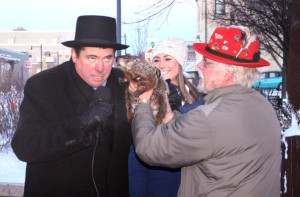
Then-mayor Jon Freund, left, leans in for Jimmy the Groundhog’s prognostication on Feb. 2, 2015 — just before he was famously bitten on the ear by the groundhog during Sun Prairie’s Groundhog Day celebration. The roots of Groundhog Day date back to the 6th century. (Photo credit: Associated Press)
Groundhog Day is an example of predicting the weather based on folklore. If the groundhog comes out of its hole and sees its shadow, we are in store for 40 more days of winter. Of course, after Feb. 2, there are only 47 days left of astronomical winter – which ends on or about March 21.
The roots of Groundhog Day go back to the 6th century. Feb. 2 is 40 days after Christmas and is known as Candlemas. On this day, candles that are used for the rest of the year are blessed. This is also about the mid-point in winter, in meteorological not astronomical terms.
The forecast rhyme goes:
If Candlemas Day is bright and clear,
There’ll be two winters in that year;
But if Candlemas Day is mild or brings rain,
Winter is gone and will not come again.
If the day is bright and clear, the groundhog “sees” his shadow and we have more winter. Of course, the weather conditions on Feb. 2 at single locations like Sun Prairie or Punxsutawney, Pennsylvania, tells us nothing about the weather for the rest of the winter season.
As for accuracy — the “predictions” made by the various rodents involved in this annual event are correct about 40 percent of the time — vastly inferior to what is delivered by modern science. Right or wrong, they are fun community celebrations.

